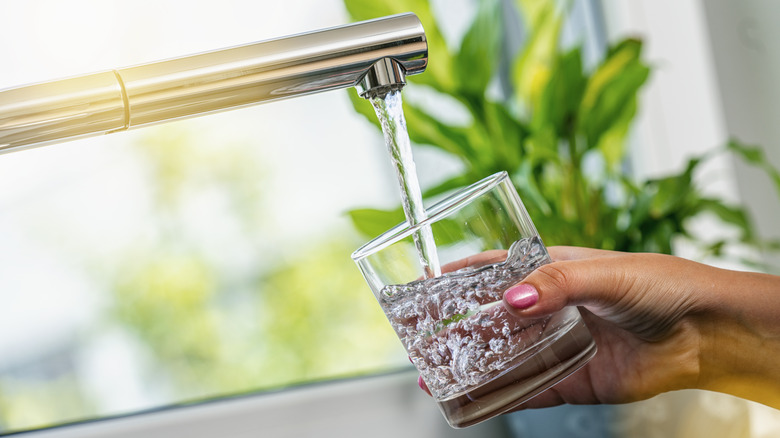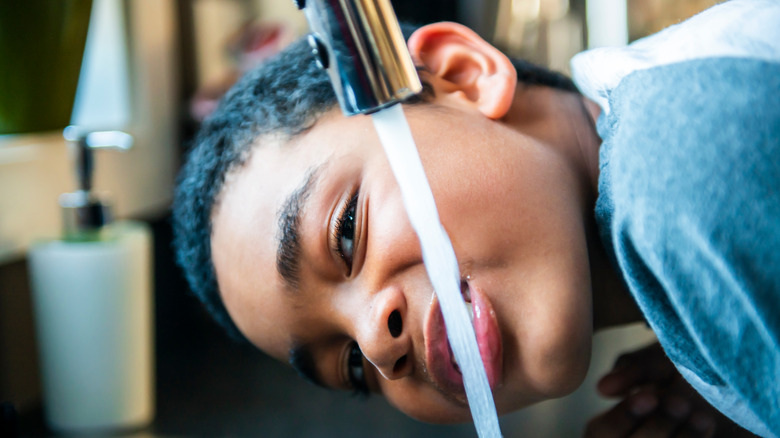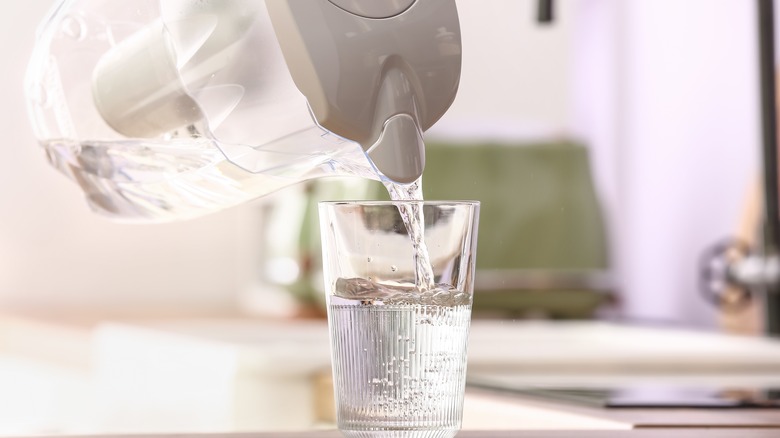If Your Tap Water Tastes Like A Swimming Pool, This Could Be Why
Water tastes like ... well, water. Unless of course it tastes like bleach or dirt or rotten eggs. These are just a few of the complaints people have from time to time about their municipal tap water. Perceptions of water quality are often based on its aesthetic properties, so any issues with taste or odor can make people uneasy about drinking from their faucets. In fact, an estimated 60 million people in the U.S. do not drink their tap water, and 39% of adults believe that bottled water is safer than tap water. In truth, tap water is more strictly regulated than bottled water, and while serious water contamination issues exist in some communities, most tap water is safe to drink.
But just because tap water is safe, doesn't mean it's tasty. Chemical flavors can be particularly off-putting. Fortunately, if your water tastes or smells like a swimming pool, it's probably not a cause for alarm. Chlorine is very frequently used as a cleaning agent in swimming pools, and it's also used to get rid of harmful materials in tap water. But a little bit of chlorine is very unlikely to hurt you.
Why your tap water tastes like a swimming pool
The water that flows from your tap usually comes from aboveground sources — like lakes, rivers, and reservoirs — or underground sources like aquifers. Because these water sources contain a variety of pollutants and germs that can make people sick, the water must pass through a multi-stage treatment process before it is safe to drink. During the last stage in this decontamination process, chemicals like chlorine or chloramine (a compound made by combining chlorine and ammonia) are added to disinfect the water and kill harmful bacteria, parasites, and viruses.
Because chlorine is usually associated with swimming pools and cleaning products, a bleach-like smell in your home drinking water may seem alarming. However, as long as the amount of chlorine or chloramine doesn't exceed 4 parts per million (ppm), there are no health risks. If you suspect your chlorine levels are higher than this, you can use a water testing kit to ensure your water is safe to drink.
Chlorine levels in most municipal drinking water are between 0.5 and 2 ppm. But even at a level of 1 ppm, you may be able to smell and taste the chlorine. Interestingly, studies indicate that some people actually like the taste of chlorinated water. These people are more likely to drink tap water than those who consume only bottled water.
What you can do to make your water taste better
If you're not one of those people who like the taste of chlorine and you want your tap water to taste less like a swimming pool and more like a fresh mountain spring, there are a few things you can try. Any pitcher or sink-mounted filtration system that uses activated charcoal should remove the taste and smell. Activated charcoal differs from ordinary charcoal because it is treated with oxygen to create tiny holes, or pores, between the charcoal particles. Chlorine and other impurities get stuck in these pores and are removed from the water. Eventually, all the pores get filled and the filter should be replaced immediately when that happens.
But filtration systems can be pricey, especially when you factor in the additional cost of replacing filters. Fortunately, there are less expensive alternatives. You can remove the chlorine taste by leaving an uncovered container of water out on the counter or in the refrigerator for 24-48 hours. Because chlorine is a volatile chemical, it readily evaporates out of the water. This process will take a bit longer in a cold environment like your fridge. To speed up the evaporation, you can boil the water for 10-20 minutes. Adding lemon slices to water can also improve the taste because ascorbic acid (vitamin C) helps neutralize the chlorine. While these methods aren't perfect, they'll make your water taste a bit more like ... well, water.


